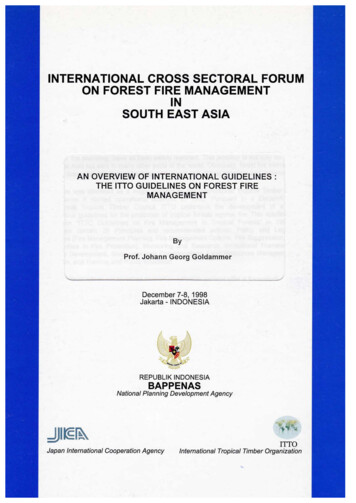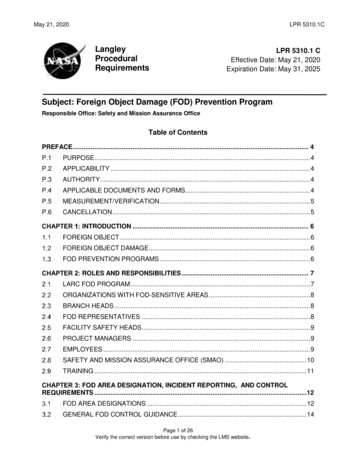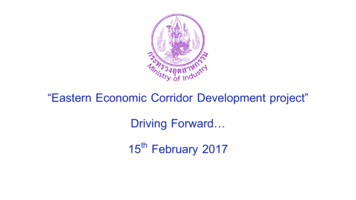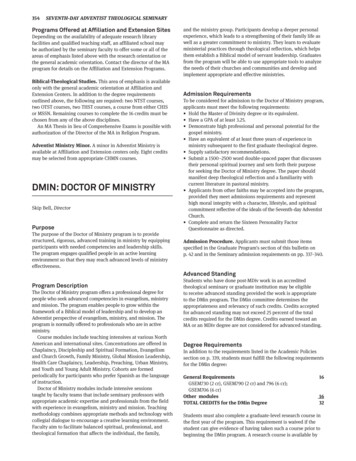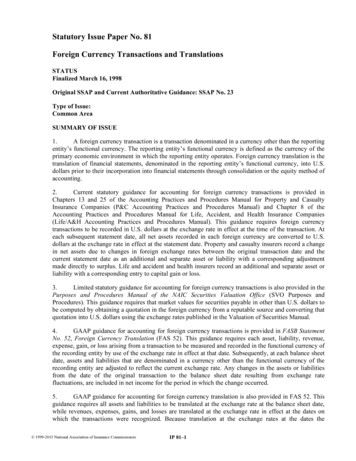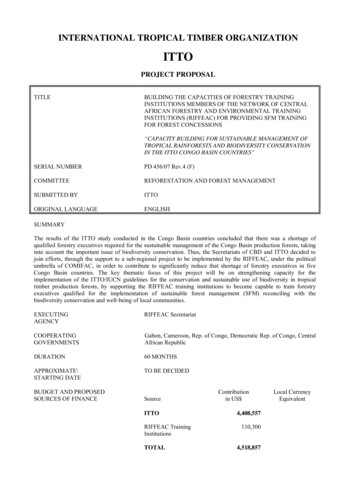
Transcription
INTERNATIONAL TROPICAL TIMBER ORGANIZATIONITTOPROJECT PROPOSALTITLEBUILDING THE CAPACITIES OF FORESTRY TRAININGINSTITUTIONS MEMBERS OF THE NETWORK OF CENTRALAFRICAN FORESTRY AND ENVIRONMENTAL TRAININGINSTITUTIONS (RIFFEAC) FOR PROVIDING SFM TRAININGFOR FOREST CONCESSIONS“CAPACITY BUILDING FOR SUSTAINABLE MANAGEMENT OFTROPICAL RAINFORESTS AND BIODIVERSITY CONSERVATIONIN THE ITTO CONGO BASIN COUNTRIES”SERIAL NUMBERPD 456/07 Rev.4 (F)COMMITTEEREFORESTATION AND FOREST MANAGEMENTSUBMITTED BYITTOORIGINAL LANGUAGEENGLISHSUMMARYThe results of the ITTO study conducted in the Congo Basin countries concluded that there was a shortage ofqualified forestry executives required for the sustainable management of the Congo Basin production forests, takinginto account the important issue of biodiversity conservation. Thus, the Secretariats of CBD and ITTO decided tojoin efforts, through the support to a sub-regional project to be implemented by the RIFFEAC, under the politicalumbrella of COMIFAC, in order to contribute to significantly reduce that shortage of forestry executives in fiveCongo Basin countries. The key thematic focus of this project will be on strengthening capacity for theimplementation of the ITTO/IUCN guidelines for the conservation and sustainable use of biodiversity in tropicaltimber production forests, by supporting the RIFFEAC training institutions to become capable to train forestryexecutives qualified for the implementation of sustainable forest management (SFM) reconciling with thebiodiversity conservation and well-being of local communities.EXECUTINGAGENCYRIFFEAC SecretariatCOOPERATINGGOVERNMENTSGabon, Cameroon, Rep. of Congo, Democratic Rep. of Congo, CentralAfrican RepublicDURATION60 MONTHSAPPROXIMATE\STARTING DATETO BE DECIDEDBUDGET AND PROPOSEDSOURCES OF FINANCESourceITTORIFFEAC TrainingInstitutionsTOTALContributionin US 4,408,557110,3004,518,857Local CurrencyEquivalent
PROJECT BRIEF1. Context and problem to addressIn the framework of the International Year on Biodiversity (IYB) 2010, a Memorandum of Understanding(MOU) between the Secretariat of the Convention on Biological Diversity (CBD) and the Secretariat ofthe International Tropical Timber Organization (ITTO) was signed on 2 March 2010, in order to supportthe implementation of the Programme of Work on Forest Biodiversity (FPOW) of the Convention onBiological Diversity in its relation to tropical forests. This MoU was supported by the Decision on ForestBiodiversity adopted by the 10th Conference of the Parties of CBD held in Nagoya, Japan, on 18-29October 2010, which recommends the development of collaborative actions between the twoSecretariats to strengthen the implementation of the CBD Programme of Work on Forest Biodiversity inITTO Producer Member Countries.This sub-regional project is part of the implementation of the CBD/ITTO collaborative initiative in theCongo Basin, which will be in conformity with the objectives of both institutions, in relation tosustainable forest management and biodiversity conservation.2. Project objectives and indicators of their achievement2.1 Development objective and impact indicatorsThis project will contribute to building human resources capacities required to achieve sustainableforest ecosystem management in the Congo basin by reconciling social economic imperatives and themaintenance of ecological balances.The main long-term impact indicator of this project is as follows: By 2016, the competent personnel for SFM and biodiversity conservation has increased by 50 to60% and made available for forest concessions, administrations, entreprises, NGOs, CBOs andconsultant firms2.2 Specific objective and outcome indicatorsTo build the capacities of environmental and forestry training institutions in Central Africa to ensure theyare capable to train personnel qualified to implement sustainable forest management, while ensuringthe biodiversity conservation in the Congo Basin.The outcome indicators of this project are the following: By 2016, each RIFFEAC training institutione provides training in SFM and biodiversity conservationaccording to revised, harmonized and validated modules/programmes and related methodologies By 2016, each training institution has appropriate training equipment and materials available torespond to the requirements of modern teaching/training modules and related methodologies andthe need to improve professional comptences, in SFM and biodiversity conservation. By 2016, at lead 120 trainers and other personnel trained or re-trained in SFM and biodiversityconservation.3. Beneficiaries, Results and expected OutputsThe Project stakeholders had been identified during the execution of project PD 189/03 Rev.1 (I)"Support Project for the Updating of Training in Forest Management and Forest ConcessionManagement in Central African Forestry Schools (Gabon)". They include forestry training institutions,forest concessionnaires, forest industries, NGOs, the relevant authorities and other support projectsincluding donors and international organizations involved in the forest sector in the Congo Basin.At project completion, RIFFEAC member institutions providing forestry and environmental training in thesub-region will be capable to train personnel to the standards required for them to implementsustainable forest concession management in the Congo Basin, while ensuring bio-diversityconservation. The outcomes at project completion can be summarized as follows:2
The contents of six reference training modules/programmes relating to sustainable managementof forest concessions and biodiversity conservation have been revised, reviewed, adapted,harmonized, validated and approved by training institutions, based on the RIFFEAC sub-regionalstrategy. A teaching methodology to implement each training module/programme with bettertrained trainers and a kit of training materials including the required basic components has beenvalidated and approved by RIFFEAC members. The full-time trainers (110 in the sub-region) and supernumerary/part-time trainers (170) in sevenRIFFEAC founding members have been updated and/or trained on the utilization of equipmentand materials acquired for the the capacity reinforcement in relation to the six harmonized trainingmodules/programmes. RIFFEAC member institutions are equipped with equipment, materials and infrastructuresappropriate to the requirements of modern teaching methodologies and the requirements of moreadvanced vocational training courses. The annual shortage of 620 qualified forestry executives have been gradually reduced, by 50 to60%, for the purpose of sustainable management of forest concessions and biodiversityconservation in the Congo Basin countries., thanks to the implementation of this project by sevenRIFFEAC training institutions. The level of reduction of the shortage could be more that 50 to60%, as the reference training modules/programmes and related teaching methodology will beshared and used by other RIFFEAC training institutions. Communication flows and the sharing of know-how among RIFFEAC members and with otherSFM stakeholders (such as private sector) have been improved and the role of RIFFEAC as acoordination mechanism under the COMIFAC Plan of Convergence has been enhanced;4. Project implementation strategySince the creation of the Central African Forest Commission (COMIFAC) in 1999, by the Head of Statesof the Congo Basin countries, ITTO is cooperating with COMIFAC for the promotion of SFM andbiodiversity conservation in their common member countries.In the curent organizational chart of COMIFAC, RIFFEAC has been identified as the leading structure incharge of the implementation of the Priority Action 7 of the Plan of Convergence developed by theCentral African Forest Commission (COMIFAC) dealing with the capacity building, stakeholdersinvolvement, information and training. The RIFFEAC network is considered as the appropriate interfacebetween the Congo Basin countries and international partners (bilateral and multilateral) on the capacitybuilding/reinforcement regarding the forestry and environment aspects, in order to avoid duplication ofmeans and efforts in that African sub-region.This regional approach has been driving the cooperation between the Congo Basin countries and ITTOthrough COMIFAC and its relevant technical structure (RIFFEAC) and contributing to building and/orreinforcing the human, technical and institutional capacities of seven RIFFEAC founding members, inorder to ensure that those institutions become capable to train personnel qualified for theimplementation of sustainable forest management (SFM) while reconciling with the biodiversityconservation and well-being of local communities.5. How will project results be made sustainable after project completionThe sustainability of key project results can be ensured, after the project completion, through theeffective ownership of the six harmonized reference training modules/programmes finalized, validatedand approved by the RIFFEAC member institutions and trainers who have been involved in the entireprocess. These trainers are also the primary beneficiairies of the project outputs, as the main users ofthese training modules/programmes they have contributed to develop, validate and approve through aparticipatory/consultation process with national and international partners.Providing support to the RIFFEAC training institutions and promoting the new curricula on SFM andbiodiversity conservation are one of the best ways to promote the sustainability and long term positiveimpact of the project results in the Congo Basin sub-region, as the qualified persons trained in theRIFFEAC training institutions will be involved in the good functionning of relevant stakeholders(Governement, private sector, NGOs, etc.) dealing with SFM and biodiversity conservation.3
Under the political umbrella of COMIFAC, another important element for the sustainability of the mainproject results is due to its implementation by RIFFEAC, the technical structure in charge of theimplementation of the Priority Action 7 of the Plan of Convergence of COMIFAC. This will facilitate theinstitutionalization of the main project results, and contribute to sustain them in the Congo Basincountries.6. Major assumptions and risksThe following risks may hinder the smooth implementation of the project but mitigation measures arealso provided for each as hereafter : The reluctance by certain trainers who find it difficult to revise the content of their training coursesand get them adapted to RIFFEAC criteria; this reluctance could be the result of the constraintsmentioned above, i.e. access to documentation. Staff turnover in training institutes: staff turnover, especially among management personnel duringthe project implementation period, could seriously undermine the dynamics and momentum built-upby the former managers. Lack of interest from logging and timber processing companies who have been frustrated by theinability of forest training institutes to meet their demand for qualified personnel.Insufficient additional support to achieve the project objectives.Lack of commitment by Governments to effectively build the capacities of the training institutes. 4
Table of contentsPartPART 11.11.21.2.11.2.21.2.31.31.3.11.3.21.4PART 22.12.1.12.1.22.1.32.1.42.22.2.12.2.2PART 13.5.2PART 44.14.1.14.1.24.1.34.1.44.24.34.3.14.3.2ANNEX 1ANNEX 2ANNEX 3ANNEX 4HeadingProject briefList of abbreviations and acronymsMap of the areaPROJECT CONTEXTOriginRelevanceConformity with ITTO’s objectives and prioritiesConformity with CBD Programme of Work on Forest BiodiversityRelevance to the submitting countries’ policiesTarget areaGeographic locationSocio-economic, technical and environmental aspectsExpected outcomes at project completionPROJECT RATIONALE AND OBJECTIVESRationaleInstitutional set-up and organizational issuesStakeholders analysisProblem analysisLogical framework matrixObjectivesDevelopment objective and impact indicatorsSpecific objective and outcome indicatorsDESCRIPTION OF PROJECT INTERVENTIONSOutputs and activitiesOutputsActivitiesImplementation approaches and methodsWork planBudgetMaster budget scheduleConsolidated budget by componentITTO budget by componentExecuting agency budget by componentAssumptions, risks, sustainabilityAssumptions and risksSustainabilityIMPLEMENTATION ARRANGEMENTSOrganization structure and stakeholder involvement mechanismsExecuting agency and partnersProject management teamProject steering committeeStakeholder involvement mechanismsReporting, review, monitoring and evaluationDissemination and mainstreaming of project learningDissemination of project resultsMainstreaming project learningCBD/ITTO Memorandum of UnderstandingJICA/ITTO Memorandum of UnderstandingProfile of the Executing AgencyTerms of reference / development of modules and methodologiesPage 2628303032353637373738383838394040414141424651525
LIST OF ABREVIATIONS AND ACRONYMSAFLEGAfrican Forest Law Enforcement and GovernanceATIBTAssociation technique internationale des bois tropicauxATOAfrican Timber OrganizationAUFAgence Universitaire de la FrancophonieBRACRegional Office in Central Africa (IUCN)CAFTNRéseau Forêts et Commerce d’Afrique Centrale (Forest and Trade Network in Central Africa)CARCentral African RepublicCARPOCentral Africa Regional Programme Office of WWFCBDUnited Nations Convention on Biological DiversityCBFPCongo Basin Forest Partnership FundCBOCommunity Based OrganizationCEFDHACConférence sur les écosystèmes forestiers denses et humides de l’Afrique Centrale (TheBrazzaville Process)CIBTInternational Tropical Timber CouncilCIFORCenter for International Forestry ResearchCIRADCentre International de Recherche Agricole pour le DéveloppementCOMIFACConférence des Ministres sur la Conservation et la Gestion Durable des Forêts d’AfriqueCentrale -- Central African Forest CommissionCPFCollaborative Partnership on ForestsCRESACentre Régional d’Enseignement Spécialisé en Agriculture Forêt-BoisDESSDiplôme d’Etudes Supérieures Spécialisées (a post-graduate diploma)DGISDutch CooperationDRCDemocratic Republic of the CongoDUTDiplôme Universitaire de technologie (a 2-year Polytechnics Graduation Certificate)EFGEcole pour la Formation des Spécialistes de la Faune de Garoua, CameroonENEFEcole Nationale des Eaux et Forêts, GabonERAIFTEcole Régionale Post-Universitaire d’Aménagement et de Gestion Intégrés des ForêtsTropicales (DRC)EUEuropean UnionFAOFood and Agriculture OrganizationFASAFaculty of Agronomy and Agricultural Sciences -- Université de Dschang (Cameroon)FORAFRIProject Régional de Capitalisation et de Transfert des Résultats des Recherches menéesdans les Forêts denses humides d’AfriqueFORINFOProject Formation et Recherche pour l’Appui au Développement Durable du secteur Foret Environnement en Afrique Centrale.GDFSustainable Forest ManagementGTZGesellsschaft für Technische Zumsammenarbeit (German oveseas cooperation agency)ICRAFInternational Center for Research in AgroforestryIDRRural Development Institute -- Université Marien Ngouabi, Congo6
IFIAInterafrican Forest Industries AssociationISDRInstitut Supérieur de Développement Rural de Mbaiki, CARITTOInternational Tropical Timber OrganizationJICAJapanese International Cooperation Agency2KmSquare-kilometreLMDLicence -Master - Doctorat (Bachelor – Master – PhD)MAEFrench Ministry of Foreign Affairs.MOFAMinistry of Foreign AffairsNGONon-Governmental OrganizationOFACObservatory of Central African Forests (Observatoire des Forets d’Afrique Centrale)PCIPrinciples, Criteria and IndicatorsRAPACRéseau des Aires Protégées d’Afrique Centrale (Network of Protected Areas in Central Africa)RIFFEACNetwork of Central African Forestry and Environmental Training Institutions (Réseau desInstitutions de Formation Forestière et Environnementale d’Afrique Centrale)SFMSustainable Forest ManagementSIG/GISGeographic Information SystemTFFTropical Forest FoundationTIC/ICTTechnique d’information et de la communication / Information and CommunicationTechnologiesTORTerms of ReferenceUICN (IUCN)International Union for the Conservation de la Nature (World Alliance for Nature)UNDPUnited Nations Development ProgrammeUNFFUnited Nations Forum on ForestsWCSWildlife Conservation SocietyUVUnit de valeur (Course Credit)WWFWorld Wilde Fund for Nature (Fonds mondial pour la nature)7
Map of project areaFor this sub-regional RIFFEAC project the geographical location of each training institution isshown the following map:Congo Basin vegetation and main protected areas landscape map (source : WRI/GFW, 2008)Location of seven RIFFEAC training institutionsLocation of forest sites for field practical work used by the RIFFEAC training institutions8
PART 1: PROJECT CONTEXT1.1 OriginThe demand for sustainable forest management (SFM) training is increasing in proportion to thechallenges faced by the Congo Basin countries where the development of SFM is less advanced thanin Asian and Latin American countries: 17% for Africa (mostly in the Congo Basin), 54% for Asia and29% for Latin America of 36 millions ha of tropical forests sustainably managed in ITTO producingmember countries (SFM Tropics 2005, ITTO), despite the increasing roles the Congo Basin forests willplay in the future. Those roles include the following: poverty alleviation and human development,biodiversity conservation, maintenance of global ecological balance, within a an integrated sustainablemanagement of tropical forests in the Congo Basin sub-region.The Congo Basin forests still boast interconnected tracts of tropical rain forests with importantpopulations of large mammals. These forests harbors the most diverse assemblage of plants andanimals including over 400 mammal species, more than 1,000 bird species, and likely over 10,000 plantspecies of which some are endemic. Only in the Congo Basin sub-region do gorrillas, forest buffaloes,bongo, and okapi occur in large numbers across large areas of natural forests. Therefore, there is aneed for trained personnel to manage this important bioversity of high value for our planet.The results of the ITTO study conducted in the Congo Basin countries concluded that there was ashortage of qualified persons required for the sustainable management of the Congo Basin forests,taking into account the important issue of biodiversity conservation. The annual shortage of humanresources would be estimated to 180 engineers and 440 technicals (620 Forestry Executives), to beused at the high level of decision making regarding the SFM issues, for the Congo Basin countries (HiolHiol and Simula, 2006).In the framework of the International Year on Biodiversity (IYB) 2010, a Memorandum of Understanding(MOU) between the Secretariat of the Convention on Biological Diversity (CBD) and the Secretariat ofthe International Tropical Timber Organization (ITTO) was signed on 2 March 2010, in order to supportthe implementation of the Programme of Work on Forest Biodiversity (FPOW) of the Convention onBiological Diversity in its relation to tropical forests. This MoU was supported by the Decision on ForestBiodiversity adopted by the 10th Conference of the Parties of CBD held in Nagoya, Japan, on 18-29October 2010, which recommends the development of collaborative actions between the twoSecretariats to strengthen the implementation of the CBD Programme of Work on Forest Biodiversity inITTO Producer Member Countries.This sub-regional project is part of the implementation of the CBD/ITTO collaborative initiative in theCongo Basin, which will be in conformity with the objectives of both institutions in relation to sustainableforest management and biodiversity conservation.The successful holding of the tenth meeting of the Conference of the Parties (COP 10), in Nagoya, 1829 October 2010, was an opportunity for Japan to take a leading role in promoting biodiversityconservation world wide. The Japanese Government’s initiatives and vision of “Living in Harmony withNature”, the adopted mission to “take effective and urgent actions towards halting the loss ofbiodiversity by 2020” would contribute to that leadership during the Japanese chairmanship of the CBDuntil COP-11 in 2012.At its 32nd session held in Bali (13-18 May 2002), the International Tropical Timber Council (ITTC)decided to participate in the the "Partnership/Type II Initiative" for the Congo Basin in preparation of theforthcoming World Summit on Sustainable Development (WSSD). Decision 10(XXXII) of ITTC providedfor an assistance to the Network of Central African Forestry and Environmental Training Institutions(Réseau Régional des Institutions de Formation Forestière - RIFFEAC) through the conduct of oneSFM training workshop for trainers. The Decision provided for additional activities in support of theNetwork of Central African Forestry and Environmental Training Institutions (RIFFEAC). This projectproposal has been developed based on the results and findings of these additional activities andprojects.9
Since 2000, RIFFEAC member institutions have been actively expanding their role to contribute to theITTO 2000 Objective. The revision of training programmes was initiated in April 2000 during a workshopfor the adaption of training modules/programmes to the context of sustainable forest ecosystemmanagement. After a baseline assessment of the current gap between existing forestry trainingprogrammes and the changing concepts and practices prevalent in the sector, seven forestry schools inthe sub-region have engaged in a collective approach to overhaul their respective training programmesthrough sub-regional cooperation.RIFFEAC was created after a meeting of forestry and environmental training institutions held inLibreville, Gabon, on 4th and 5th October 2001. By signing the "Libreville Declaration" the managers ofsignatory institutions became committed to a mutual collaboration towards the implementation of sharedobjectives and they sought the support of Central African States, the international community, NGOsand the private sector to achieve theses objectives successfully. The RIFFEAC Network wasestablished for facilitating and steering the overall arrangement.The main objective of RIFFEAC is to promote inter-institutional collaboration at sub-regional levelbetween training institutions in order to improve training standards and address the needs ofsustainable management of forest ecosystems in the Congo Basin. RIFFEAC priority actions are asfollows: a) to promote the involvement of all stakeholders in sustainable forest ecosystem management;b) to incorporate the notion of sustainable forest management in the training programmes of memberinstitutions; c) to harmonize training programmes and activities among member institutions; d) to reviewcommon problems and seek solutions, and e) to promote knowledge and experience sharing betweenmembers, especially in training and research areas.Therefore, the Secretariats of CBD and ITTO decided to join efforts and submit a proposal to potentialdonors in order to promote, in partnership with five Congo Basin countries, the SFM and conservationof tropical production forest biodiversity in that mega-diversity region. This project will contribute to buildand/or reinforce the human, technical and institutional capacities of seven RIFFEAC training institutionsoperating in Central Africa sub-region, in order to ensure that those institutions become capable to trainpersonnel qualified for the implementation of sustainable forest management reconciling with thebiodiversity conservation and well-being of local communities.1.2 Relevance1.2.1 Conformity with ITTO’s objectives and prioritiesThe RIFFEAC sub-regional project will contribute to the implementation of the ITTO Council Decision6(XLIV) that adopted the “ITTO-IUCN Guidelines for the conservation and sustainable use ofbiodiversity in tropical timber production forests” and Decision 6(XLVI) on “ITTO/CBD CollaborativeInitiative to conserve tropical forest” through the inclusion of the biodiversity conservation requirementsin the harmonized training modules to be used in the training institutions operating in the Congo Basinsub-region. It will also contribute to the promotion of good practices regarding the sustainable forestmanagement in relation to the biodiversity conservation and livelihoods, in the ITTO Congo Basincountries, in conformity with the following Objectives of ITTA 2006 (Article 1):m) Encouraging members to develop national policies aimed at sustainable utilization and conservationof timber producing forests, and maintaining ecological balance, in the context of the tropical timbertrade;n) Strengthening the capacity of members to improve forest law enforcement and governance, andaddress illegal logging and related trade in tropical timber;o) Encouraging information sharing for a better understanding of voluntary mechanisms such as, interalia, certification, to promote sustainable management of tropical forests, and assisting members withtheir efforts in this area;p) Promoting access to, and transfer of, technologies and technical cooperation to implement theobjectives of this Agreement, including on concessional and preferential terms and conditions, asmutually agreed;q) Promoting better understanding of the contribution of non-timber forest products and environmentalservices to the sustainable management of tropical forests with the aim of enhancing the capacity ofmembers to develop strategies to strengthen such contributions in the context of sustainable forest10
management, and cooperating with relevant institutions and processes to this end.It is also in conformity with the following Actions contained in the ITTO Action Plan 2008-2011 andregarding the following cross cutting actions:Capacity buildingk) Assist human resource development by conducting national, regional and international trainingactivities, the provision of fellowships, and by supporting institutional/legal strengthening.l) Strengthen cross-sectoral approaches linking government, industry, trade and civil society.International cooperationn) Actively cooperate and coordinate with other international organizations and with internationalforums and regional initiatives that undertake activities relevant to ITTO’s objectives, with a view tosharing expertise, reducing duplication, enhancing complementarity and harmonizing activities.o) Contribute to the work of the CPF, UNFF and the global environmental conventions to further theshared objective of promoting SFM.1.2.2 Conformity with CBD Programme of Work on Forest BiodiversityThe RIFFEAC sub-regional project will prioritize activities related to relevant goals identified in CBD’spost-2010 Strategic Plan, specifically to the following targets: Target 7: By 2020 areas under agriculture, aquaculture and forestry are sustainably managed,ensuring conservation of biodiversity; andTarget 14: By 2020 ecosystems that provide essential services and contribute to health, livelihoodsand well-being are safeguarded and/or restored and equitable access to ecosystem services isensured for all, taking into account the needs of women, indigenous and local communities and thepoor and vulnerable.The main forest element of support to the CBD Strategic Plan is its Programme of Work on ForestBiodiversity (PWFB), which consists of three main Programme Elements, 12 Goals, 27 Objectives, and130 Actions. The sub-regional project will specifically be in conformity with the following goals of thePWFB: Goal 1.3: Protect, recover and restore forest biological diversityGoal 1.4: Promote the sustainable use of forest biological diversityGoal 2.1: Enhance the institutional enabling environmentGoal 3.2: Improve knowledge on and methods for the assessment of the status and trends of forestbiological diversity1.2.3 Relevance to the submitting countries’ policiesThe RIFFEAC sub-regional project will be in conformity with the sub-regional policies in the CongoBasin set forth in the Plan of Convergence developed by the Central African Forest Commission(COMIFAC). The Plan of Convergence is a common platform for priority actions to be implemented atthe sub-regional and national levels. The Plan of Convergence includes sub-regional actions to beimplemented together by COMIFAC signatory States and the compilation of specific national actionprogrammes of each signatory State member.The implementation of the sub-regional project is mainly related to the Priority Action 7 of the Plan ofConvergence dealing with capacity building, stakeholders involvement, information and training. TheComponent 7.4 of the Priority Action 7 identifies objectives dealing the consolidation and developmentof institutions and synergies in the training sector. The four activities under this component address thefollowing aspects: harmonisation of training modules/programmes, promotion of further specialisationamong Institutes, improvement of training institutions and adoption of a sub-regional strategy onvocational training, with the overall aim of promoting the sustainaible forest management andbiodiversity conservation.11
For this RIFFEAC sub-regional project, it will have wider values and benefits for the Congo Basincountries, as the capacity building will be dealing with the forestry sector which has a great impact onthe economy of these countries in general and on the livelihood of populations living both in urban andrural areas.1.3 Target area1.3.1 Geographic locationAs shown on the map of page x, the seven RIFFEAC training institutions to be involved in theimplementation of this project are operational in the following countries: Cameroon, Central AfricanRepublic (CAR), Democratic Republic of the Congo (DRC), Gabon and republic of Congo.The basic information and data on these five countries are represented in the following table:Table 1: Basic dat
The results of the ITTO study conducted in the Congo Basin countries concluded that there was a shortage of . 4.1.2 Project management team 38 4.1.3 Project steering committee 39 (The . ITTO International Tropical Timber Organization ) 12 1 (%) (%) (%)

